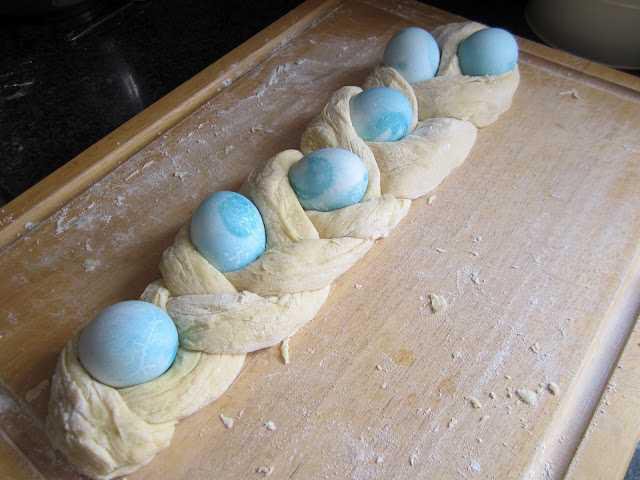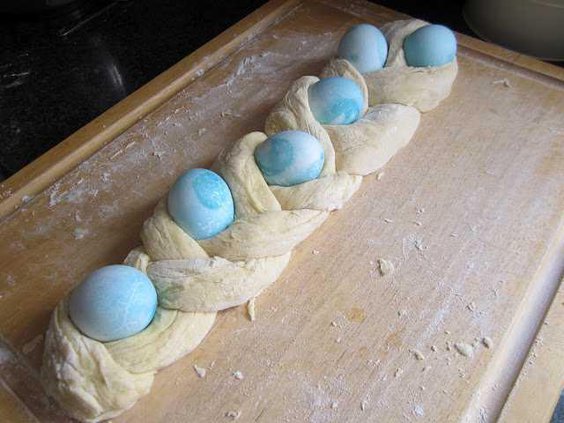I have really good intentions about what to feed the family. In reality, we mostly eat the same food day after day after day. For all of my good intentions, time and energy too often get in the way.
But then there are some recipes that are so aesthetically beautiful and seemingly not-too-hard-to-pull-off, they practically demand a chance in my own test kitchen. Such was the case with braided Easter Sweet Bread, found in an old Bon Appetit magazine.
Boiled and colored eggs baked in a soft sweet bread is not only pretty, it's delicious and unique, making it a family favorite every Easter. Inevitably, there are "oohs" and "ahs" and, "are those eggs actually boiled and than baked on top of your bread?"
Yes, it's true. Year after year, the surprise (and tastiness) never fails to disappoint.
***
Easter Sweet Bread
5-6 eggs, hard boiled, dyed
For the sweet dough:
2/3 cup whole milk
5 tablespoons sugar, divided
1 teaspoons active dry yeast
2 large eggs, room temperature
2 cups unbleached all-purpose flour
1 teaspoon kosher salt
cup (1 stick) unsalted butter, cut into 1-inch pieces, room temperature, plus tablespoon, melted
1. Heat milk in a small saucepan over medium heat or in a microwave until an instant-read thermometer registers 110115 degrees. Transfer milk to a 2-cup measuring cup; stir in 1 tablespoon sugar. Sprinkle yeast over milk and whisk to blend. Let sit until yeast is foamy, about 5 minutes. Add 2 eggs; whisk until smooth. Combine remaining 4 tablespoons sugar, flour and salt in the bowl of a stand mixer fitted with a dough hook.
2. Mix in milk mixture to dry ingredients. With mixer running, add cup room-temperature butter. Mix on medium speed for 1 minute. Knead on medium-high speed until dough is soft and silky, about 5 minutes. Brush top of dough with remaining melted butter; cover with plastic wrap. Let rise to about double.
3. Line a large baking sheet with parchment paper (or spray baking sheet). Punch down dough. Divide into three equal pieces. With lightly floured hands, roll each piece on a lightly floured surface into a 16-inch-long rope with tapered ends. (If dough begins to bounce back, cover with a kitchen towel and let rest for 10 minutes to allow dough to relax.)
4. Arrange ropes side by side lengthwise on prepared sheet. Pinch top ends together. Braid dough. Pinch bottom ends together to secure. The braided loaf will be about 12 inches long. Tuck dyed eggs between braids, spacing evenly. Loosely cover with plastic wrap or a kitchen towel. Let rise in a warm, draft-free area until puffed but not doubled in size, about 4550 minutes. Arrange a rack in middle of oven; preheat to 375 degrees F.
Optional: Whisk remaining egg with 2 teaspoons warm water in a small bowl. Avoiding dyed eggs, brush dough all over with egg wash.
Bake until bread is golden brown. Let cool on a wire rack. Serve warm or at room temperature.
Note: This can be made a day ahead. Cover dough with plastic; chill. Let dough rise in a warm, draft-free area until doubled in size, 11 hours (or 22 hours if dough has been refrigerated).
Adapted from Bon Appetit's Easter Bread recipe
But then there are some recipes that are so aesthetically beautiful and seemingly not-too-hard-to-pull-off, they practically demand a chance in my own test kitchen. Such was the case with braided Easter Sweet Bread, found in an old Bon Appetit magazine.
Boiled and colored eggs baked in a soft sweet bread is not only pretty, it's delicious and unique, making it a family favorite every Easter. Inevitably, there are "oohs" and "ahs" and, "are those eggs actually boiled and than baked on top of your bread?"
Yes, it's true. Year after year, the surprise (and tastiness) never fails to disappoint.
***
Easter Sweet Bread
5-6 eggs, hard boiled, dyed
For the sweet dough:
2/3 cup whole milk
5 tablespoons sugar, divided
1 teaspoons active dry yeast
2 large eggs, room temperature
2 cups unbleached all-purpose flour
1 teaspoon kosher salt
cup (1 stick) unsalted butter, cut into 1-inch pieces, room temperature, plus tablespoon, melted
1. Heat milk in a small saucepan over medium heat or in a microwave until an instant-read thermometer registers 110115 degrees. Transfer milk to a 2-cup measuring cup; stir in 1 tablespoon sugar. Sprinkle yeast over milk and whisk to blend. Let sit until yeast is foamy, about 5 minutes. Add 2 eggs; whisk until smooth. Combine remaining 4 tablespoons sugar, flour and salt in the bowl of a stand mixer fitted with a dough hook.
2. Mix in milk mixture to dry ingredients. With mixer running, add cup room-temperature butter. Mix on medium speed for 1 minute. Knead on medium-high speed until dough is soft and silky, about 5 minutes. Brush top of dough with remaining melted butter; cover with plastic wrap. Let rise to about double.
3. Line a large baking sheet with parchment paper (or spray baking sheet). Punch down dough. Divide into three equal pieces. With lightly floured hands, roll each piece on a lightly floured surface into a 16-inch-long rope with tapered ends. (If dough begins to bounce back, cover with a kitchen towel and let rest for 10 minutes to allow dough to relax.)
4. Arrange ropes side by side lengthwise on prepared sheet. Pinch top ends together. Braid dough. Pinch bottom ends together to secure. The braided loaf will be about 12 inches long. Tuck dyed eggs between braids, spacing evenly. Loosely cover with plastic wrap or a kitchen towel. Let rise in a warm, draft-free area until puffed but not doubled in size, about 4550 minutes. Arrange a rack in middle of oven; preheat to 375 degrees F.
Optional: Whisk remaining egg with 2 teaspoons warm water in a small bowl. Avoiding dyed eggs, brush dough all over with egg wash.
Bake until bread is golden brown. Let cool on a wire rack. Serve warm or at room temperature.
Note: This can be made a day ahead. Cover dough with plastic; chill. Let dough rise in a warm, draft-free area until doubled in size, 11 hours (or 22 hours if dough has been refrigerated).
Adapted from Bon Appetit's Easter Bread recipe








